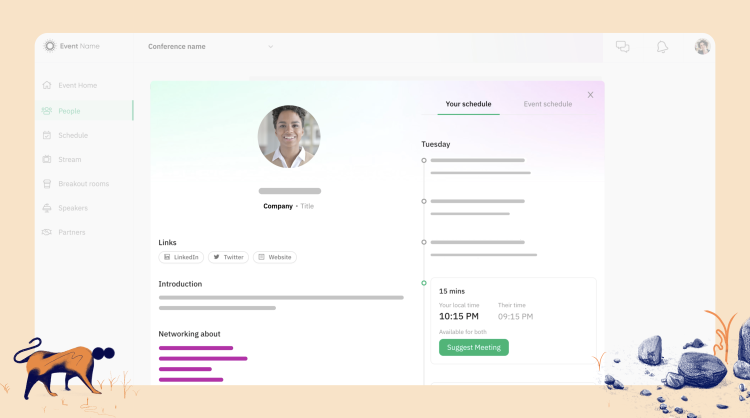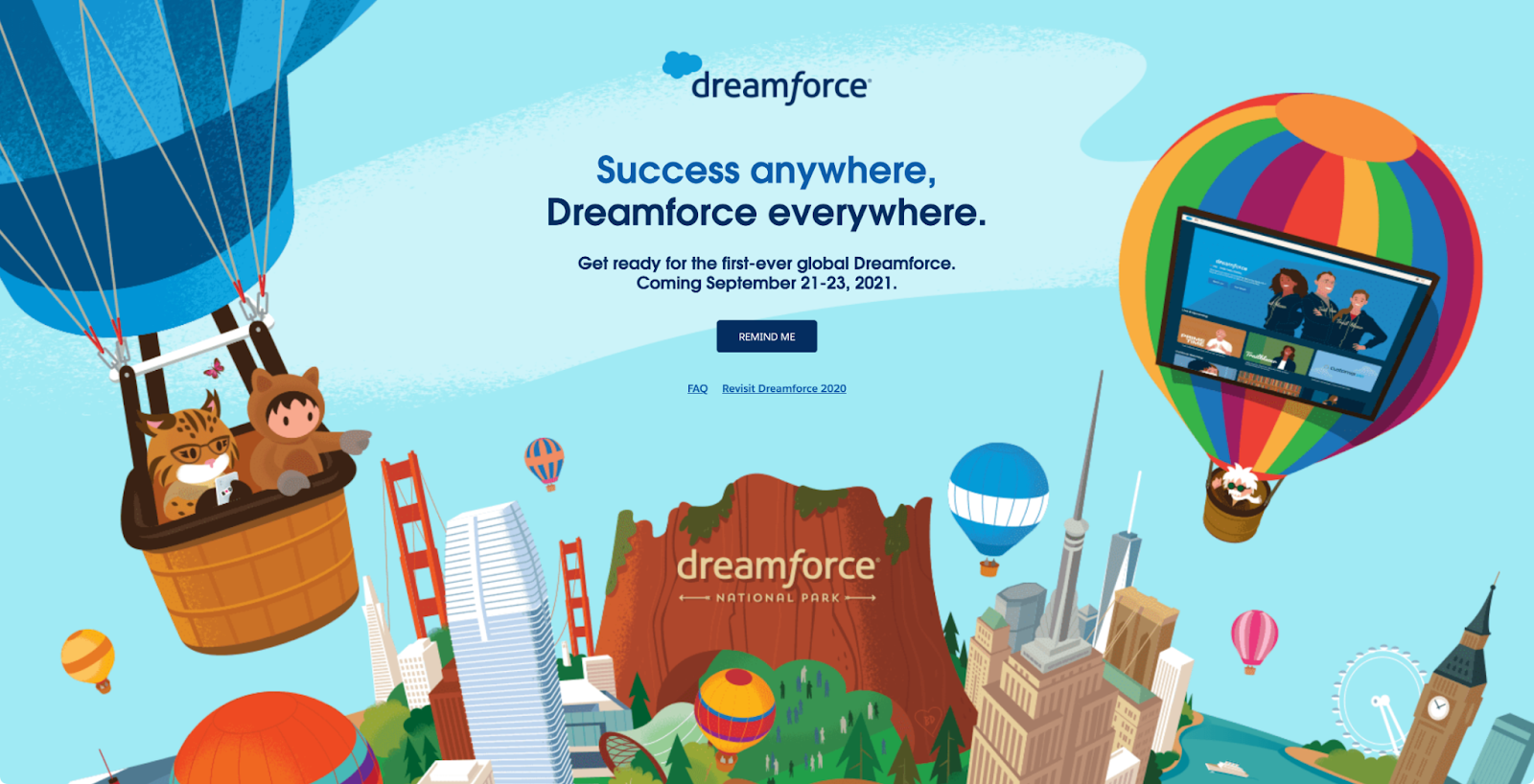What is a Hybrid Event and Why is it the Future?
Hybrid events allow us to talk and connect with customers virtually, at any time, no matter where they are.

It may have taken the COVID-19 pandemic to really push the use of hybrid and virtual events (we had no other choice, right?). But they seem to be here to stay. Not only can they reach people in other time zones, but hybrid events are also cheaper, more engaging, and give us content we can repackage and use in other marketing channels.
And once you know how to organize and run a hybrid event and you’ve invested in the right tools and technology, hosting them is a relative cinch.
In this piece, we’ll look at:
What are hybrid events?
Why we think hybrid events are the future
Ready to launch your next event? Let’s go 🚀
What are hybrid events?
Hybrid events are a mix of digital and physical elements to broadcast an event to attendees.
The goal of a hybrid event is to merge those attending virtually and in-person into one audience and have them participate in the same activities and discussions. A successful hybrid is when everyone has the same experience – no matter how they choose to attend.
As hybrid events become a permanent part of our marketing strategies, we need to figure out how to create an environment where we can organize and launch them easily. One study found that 71% of marketing professionals are now looking for better tools to engage virtual attendees. And nearly 60% want a solution where they can manage in person and hybrid events under one roof.
When talking about hybrid events, there are two types: external and internal. External events are usually organized for people outside your company, like customers, and can be used for things like:
Conferences
Live product demos
Trade shows
Exhibitions
Internal hybrid events (for teams and stakeholders) can include events like:
Training webinars
Team socials
Quarterly meetings
Leadership summits, and more.
There are many reasons, like the flexibility and the fact that people can attend them from anywhere, that have convinced us that hybrid events are the way of the future.
Why we think hybrid events are the future
I know what you might be thinking – hybrid events sound like double the work of hosting either virtual or in person events.
Not true.
If you do them well, hybrid events bring you the best of both worlds because they bring you a ton of benefits like👇
Your event will get more reach
People who can't make it to your event in person (or who don't want to) will have the option to attend virtually.
Polls from recent hybrid events show that overwhelming numbers of people wouldn't have attended if there wasn't a way to virtually. Offering people a choice to participate in-person and virtually means your event can not only reach more people, but attendees have more flexibility with how they join in.
Your audience is more engaged
Keeping an audience engaged throughout an event isn't easy.
Hybrid events give event organizers a way to merge in-person and virtual elements, like Q&A sessions and virtual forums to keep people engaged. By building a space where your in-person and virtual audience can talk to each other directly and engage with the speakers, event organizers can build an audience-first vibe that gives attendees a better experience.
You can reuse the content again (and again)
One of the best parts about hybrid events is that the virtual element gives you a way to build up a content library to recycle for future marketing activities.
Think about any event you host. There are likely speakers, Q&A sessions, and other forums bursting at the seams with useful information. If people couldn't make the event itself, you have a great opportunity to repackage these virtual content nuggets into helpful videos and blogs for your target audience.
A four-step plan to hosting a successful hybrid event
Before you make a pivot to hybrid events, let's be real: there are some differences between them and hosting a purely virtual or in-person event.
The budget will need to be overhauled, content planning will be different, and your advertising will have to match the event's new structure.
Here are four steps to create a successful hybrid event 👇
Step 1: Build a budget
The first step to organizing any hybrid event is getting your budget sorted.
Let’s get something straight. Running a hybrid event essentially means you have to merge two budgets into one (virtual and in-person.) Plan on splitting your budget down the middle: half online, half for those coming in-person so both audiences have a stand-out experience.
There are also other considerations, like:
Contracts: What in-person venue are you looking at, and is there a minimum spend? What obligations are in place for the event if you have a smaller in-person crowd?
Sponsorship: 72% of corporate sponsors want in on hybrid events. But there's a catch: they want to reach both audiences. The only way to do it is to offer them several sponsorship channels. For the virtual crowd, opportunities like sponsored virtual forums and digital branding are a good place to start, while sticking to the usual swag and onsite branding and sponsored booths for in-person attendees is a safe bet
Tax Laws: Check the tax obligations where your attendees will be tuning in from. Remember, every state, country, and venue has its own tax implications and regulations, so make sure you know what revenue you'll need to set aside to pay them
And let’s not forget one of the biggest budget items for a hybrid event – your tech stack.
Step 2: Think about your tech
When EventMB surveyed event organizers, their main frustration was the same: their virtual event tech wasn’t matching the live engagement in-person attendees were experiencing.
Although digital tools for virtual events have improved (a lot) thanks to the online pivot since early 2020, many organizers still make a simple mistake. Instead of running a hybrid event for both audiences on one platform, they launch two completely separate events and try to run them in parallel.
The in-person side of it requires:
Microphones
Lighting
Projectors/screens
Wi-Fi
Onsite tech-support
While the virtual part of the event needs:
Hybrid or virtual event platform: So you can host virtual attendees and merge your in-person event seamlessly. You’ll get bonus points if you can embed the event directly onto your site or event landing page so you’re not sending virtual participants to yet another platform.
Online support team: To deal with any tech issues your attendees have as well as making sure the event runs smoothly
Engagement tools: Like Q&A capabilities, forum rooms, and survey tools to give virtual attendees a more engaged experience
The easiest way to merge both of these? Investing in an embeddable video platform, it's the ideal hybrid event tool.

Whereby Embedded is a simple way to host hybrid events from your website
Step 3: Plan the content
The foundation of any hybrid event is the content you give your attendees.
The difficulty in creating this content is making sure it will work in-person and online. It sounds like we're beating this drum a lot, but here is where it's super important to create an experience where those attending virtually and in-person have the same level of engagement.
Creating event content that’s super engaging for every attendee requires a plan:
The type of sessions you want: Will your speakers have 15 minute slots, or one hour presentations? Will they be interactive or educational? Will there be Q&A sessions? Will your attendees have a chance to talk to the speakers one-on-one, either in-person or virtually?
How much content will be packed into each day: There is a fine line between the right amount of content and too much. How many sessions do you want to pack into a day? Will you have the content available for all attendees on-demand so they can be flexible about how they engage with the event?
It's also important to think about how each attendee can interact with different sessions and network with other people, especially if physical products are involved.
This is where having the right hybrid event tech setup is super important 👩💻
A tool like Brella AI helps event organizers match event attendees based on their shared interests, needs, and wants by capturing their information on a form. Once people are matched, they can then schedule a networking session, either on-site or virtually through a video call.

Bridging the networking gap was the exact challenge Austrian Wine faced when COVID-19 restrictions forced them to turn an in-person wine tasting into a hybrid event for the first time.
With 160 trade visitors expected, the hosts had to find a way to interact with growers and taste wine while sticking to their designated area.
"We knew that we had to pull off something where we could actually have people tasting wines, and at the same time getting in touch with the winemakers,” says Michael Tischler-Zimmermann, one of the event’s organizers.

Austrian Wine’s hybrid tasting in Moscow
To keep the element of contact alive between tasters and winemakers, the organizers:
Used an online hybrid event platform so tasters could talk to the growers in Austria in real-time
Encouraged one-on-one calls in private video meeting rooms or through live chat at virtual booths to recreate the feel of an in-person event
Gave attendees the documentation and technical information they needed to reach out to growers on their own
And the result was a huge success – 78% of attendees said they were very satisfied with the event.
"In general, we received so much good and positive feedback from our participants. Everyone was super happy about being able to have a wine tasting and the possibility to chat directly with the winemakers," says Tischler-Zimmermann.
Step 4: Get the word out
Like any event, it can only be a success if people know about it and get involved.
That's why creating a buzz and helping people spread awareness is such a vital part of any hybrid event plan. There are tons of ways you can get the word out about your hybrid event, including:
Building a dedicated landing page for attendees to register
Creating an event hashtag for people to use on social media
Asking people to share that they’re attending on their social media (and to invite colleagues and friends)
Sharing marketing material like videos and blogs to outline what to expect
Take a look at how Salesforce changed their annual event, Dreamforce, into a hybrid format.

While Salesforce has been doing its own promotion on social media, the event’s #DF21 is already helping it get traction online. Past Dreamforce attendees have been using the hashtag to share memories and tell their friends and colleagues how much they’re looking forward to September’s event.

And even if you don’t have a ton of information to add to your event’s landing page, telling attendees what to expect can help them spread the word. Salesforce is pegging their event as a global event that anyone can attend – from anywhere.
“Dreamforce 2021 will be more inclusive than ever – with digital experiences available for everyone, from anywhere. Get ready for the first-ever global Dreamforce. Combining small inspirational in-person experiences with innovative and immersive digital ones – it’s going to be one epic family reunion, all done with your safety in mind.” – Dreamforce 2021


